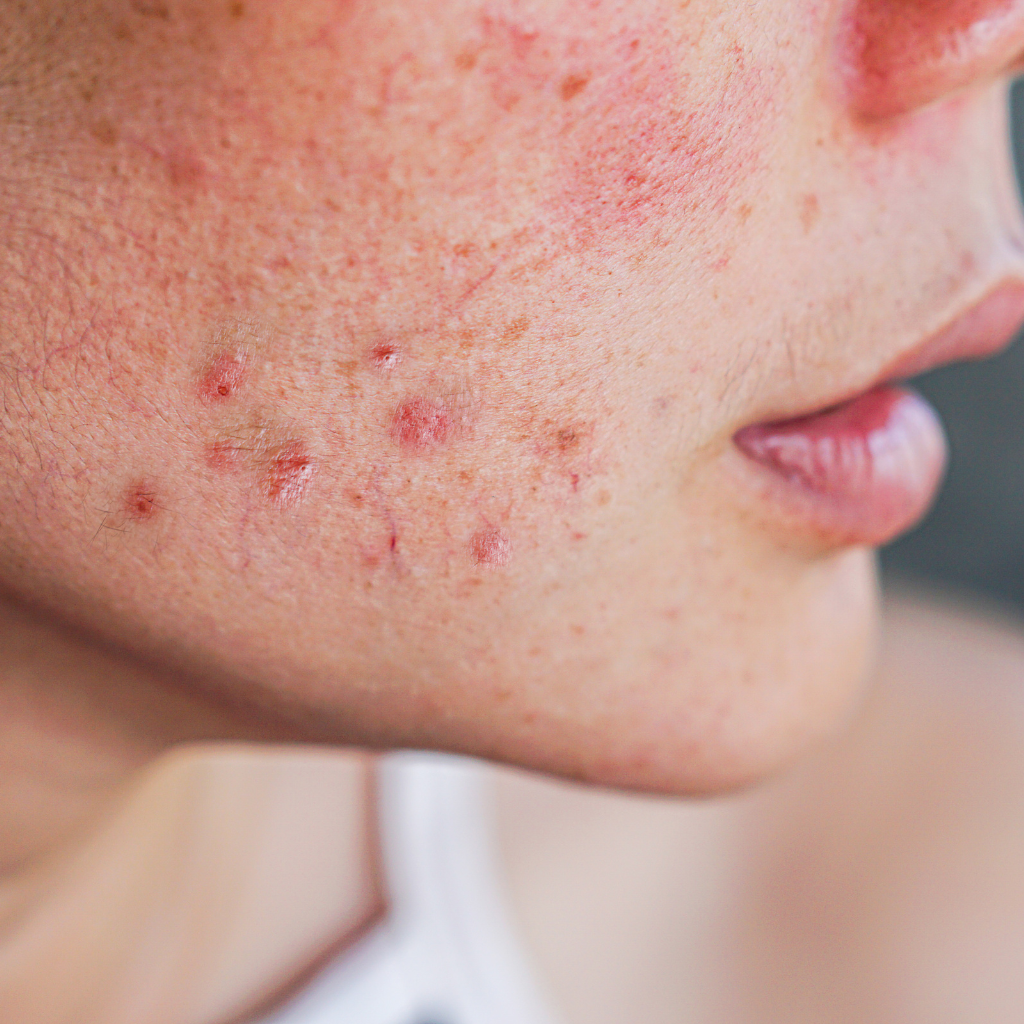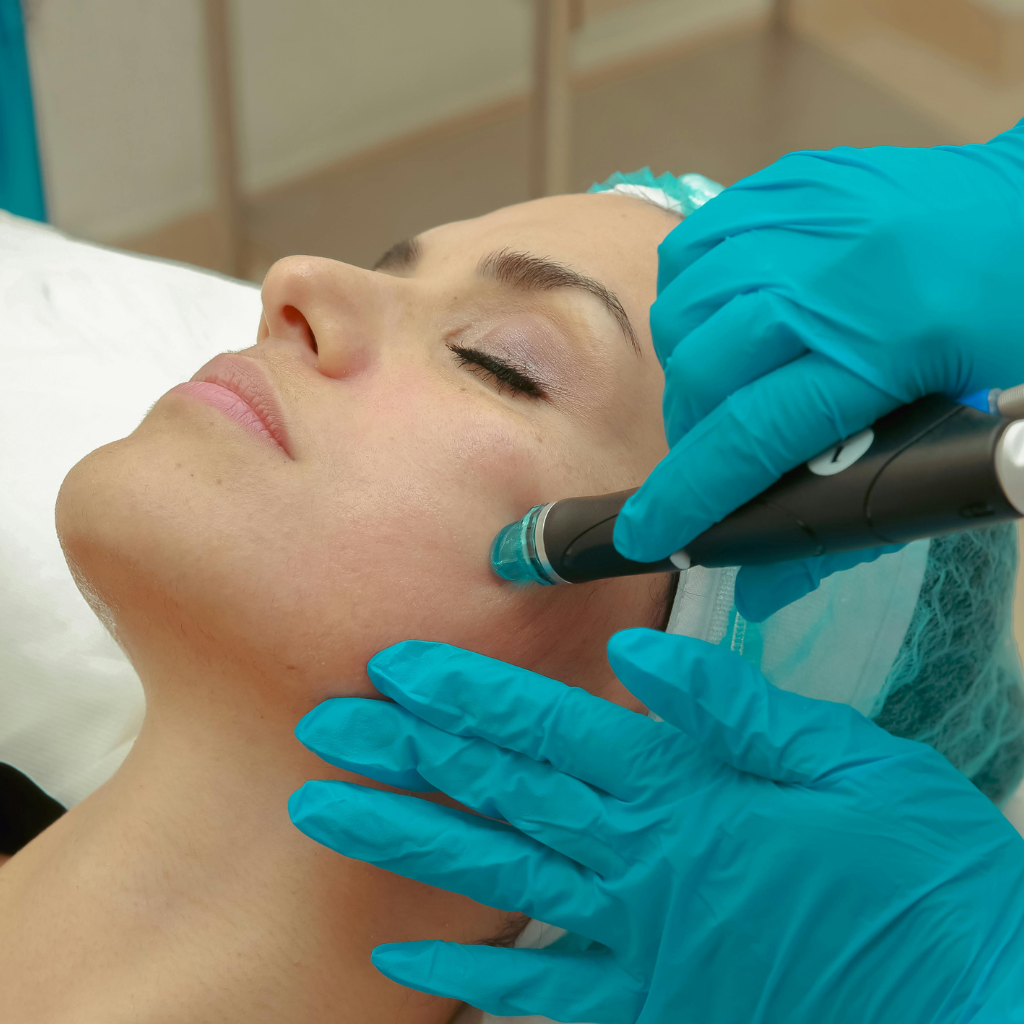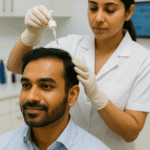How Long Does Postpartum Acne Last and What Treatment Options Help?
- Home
- Skin specialist
- how long does postpartum acne last

Postpartum acne typically persists for three to six months as hormonal levels stabilise after childbirth. It arises from hormonal fluctuations, particularly decreased estrogen and progesterone with increased androgens, leading to increased sebum production. Treatment options include topical agents like benzoyl peroxide and salicylic acid. For mild symptom relief, natural remedies such as tea tree oil and aloe vera are beneficial. Understanding personalised skincare approaches can enhance the management of postpartum acne symptoms.
Key Takeaways
- Postpartum acne typically resolves within three to six months as hormone levels stabilise.
- Topical treatments like benzoyl peroxide and salicylic acid effectively reduce acne symptoms.
- In more severe cases, prescription medications or advanced treatments such as chemical peels may be necessary.
- Consistent skincare routines and stress management can prevent acne flare-ups.
- Consult a dermatologist for persistent acne or severe breakouts causing discomfort.
What Causes Postpartum Acne and Why Does It Happen?
Postpartum acne is primarily attributed to the hormonal fluctuations experienced by mothers following childbirth.
The significant decrease in estrogen levels, coupled with a relative increase in androgen levels, can lead to increased sebum production and clogged pores, which are known precursors to acne formation.
These hormonal changes, alongside stress and sleep deprivation commonly associated with new motherhood, contribute to the development and exacerbation of acne in the postpartum period.
What Causes Postpartum Acne to Develop After Birth?
Although hormonal fluctuations are a well-documented cause of various skin conditions, postpartum acne specifically arises due to the significant shifts in hormone levels following childbirth.
During the postpartum period, the body experiences a rapid decline in estrogen and progesterone, hormones that were elevated during pregnancy and birth. This hormonal change can lead to increased sebum production, clogged pores, and ultimately, acne breakouts.
Postpartum acne usually manifests as inflammatory lesions, such as papules and pustules, often seen on the face. The stress and fatigue associated with new motherhood may exacerbate the condition.
Clinically, these hormonal changes are the primary causes of postpartum acne, making acne after giving birth a common dermatological concern for many new mothers as they develop acne.
What Is the Main Cause of Postpartum Acne in Mothers?
Shifts in hormonal levels are the primary drivers of postpartum acne in mothers. Following childbirth, significant hormonal fluctuations occur, leading to an increase in androgen production.
This hormonal surge causes the sebaceous glands may produce excess sebum during the postpartum period, leading to clogged pores and the development of acne. As a result, mothers may experience postpartum breakouts, commonly referred to as hormonal acne.
The cause of postpartum acne is intricately linked to these hormonal changes, and while these acne flare-ups are concerning, they often resolve on their own as hormone levels stabilise.
Most mothers observe that their acne usually disappears within weeks to months after childbirth. Nevertheless, understanding the underlying hormonal dynamics is essential for managing acne after childbirth effectively.
What Hormonal Changes Cause Postpartum Acne to Flare?
As a result of complex endocrinological processes, postpartum acne is primarily triggered by hormonal fluctuations that occur after childbirth.
Hormonal acne usually emerges due to elevated androgen levels, which can stimulate sebaceous glands, leading to increased sebum production. Such hormonal changes are common after delivery, as the body recalibrates from the hormonal milieu prevalent during pregnancy.
Many women experience postpartum acne as estrogen levels sharply decline and the progesterone-dominant state stabilises. This hormonal imbalance can lead to an acne flare in postpartum skin, similar to patterns observed in acne during pregnancy.
Post-pregnancy acne may require targeted interventions for effective management. Understanding these hormonal dynamics is vital for managing postpartum acne and developing evidence-based treatment strategies, minimising its impact on new mothers.
How Long Does Postpartum Acne Last for Most Women?
Postpartum acne is typically transient, with many cases resolving within three to six months as hormonal fluctuations stabilise. However, postpartum acne may last longer in some individuals, especially when influenced by stress, sleep deprivation, or hormonal imbalances associated with caring for a new baby.
The duration of postpartum acne may also be prolonged if you’re experiencing acne on your chest, back, or other areas beyond the face, which is not uncommon in postpartum individuals. Conditions like acne vulgaris may flare due to persistent hormonal shifts, and acne vulgaris during pregnancy can also extend into the postpartum period.
While you’re breastfeeding, it’s essential to choose safe treatment options—don’t apply topical acne treatments containing retinoids or other high-risk ingredients without consulting a healthcare provider.
Clinical observations suggest that individual variability in hormonal re-equilibration markedly influences how long postpartum acne may persist.
When Does Acne From Postpartum Hormones Typically Clear?
How long does it take for postpartum acne to resolve after childbirth? Fluctuations in postpartum hormones largely drive postpartum acne. For many women, acne breakouts begin to subside within three to six months postpartum as hormone levels stabilise.
However, the duration may vary depending on several factors:
- Hormonal regulation: Fluctuations due to breastfeeding can prolong acne.
- Severity of your acne: Severe cases may persist longer without adequate postpartum acne treatment.
- Skin care regimen: Effective skin care routines can expedite resolution.
- Treatment options: Utilising appropriate acne treatments can reduce the duration.
- Individual differences: Genetic predispositions and skin type influence how long postpartum acne lasts.
Early intervention with evidence-based treatment options can effectively address postpartum acne and improve skin clarity.

Does Postpartum Acne Last Longer Than Regular Acne?
Does postpartum acne persist longer than regular acne? Evidence suggests that postpartum acne duration varies among individuals, but it can indeed exceed the typical acne duration.
Postpartum acne, particularly on the cheeks, results from hormonal fluctuations after pregnancy, which may prolong acne breakouts compared to non-pregnancy-related acne. While acne usually resolves as hormone levels stabilise, the timeline is individualised.
Treatment options for postpartum acne are vital for managing symptoms and may include topical retinoids, benzoyl peroxide, and oral antibiotics, under medical guidance.
Effective postpartum acne treatment is important to cure postpartum acne and minimise its persistence. Clinical studies indicate that targeted interventions can considerably reduce the duration and severity of postpartum acne breakouts, promoting clearer skin in the postpartum period.
What Are the Symptoms of Postpartum Acne to Look For?
Postpartum acne can present with symptoms that are distinct from adolescent acne, often manifesting shortly after childbirth due to hormonal fluctuations unique to the pregnancy and postpartum period.
Clinically, acne is one of the most common dermatological concerns in new mothers. These breakouts may range in severity, from mild comedones to more severe inflammatory lesions, influenced by individual hormonal changes and increased skin sensitivity.
While hormonal shifts do not directly cause acne, they play a significant role in triggering excess oil production and clogged pores. The duration of postpartum acne varies widely, with some cases resolving within weeks and others persisting for several months.
Understanding these variations is essential for developing effective treatment strategies tailored to postpartum patients.
How Do Postpartum Breakouts Differ From Teenage Acne?
Importantly, the distinction between postpartum breakouts and teenage acne lies in their aetiology and clinical presentation.
Postpartum acne primarily results from hormonal changes following childbirth, whereas teenage acne is largely due to puberty-related hormonal surges.
Both conditions cause acne, but postpartum acne is temporary and may resolve as hormone levels stabilise. Acne breakouts typically appear on the face, but acne can occur anywhere on the body.
- Aetiology: Postpartum acne is linked to postpartum hormonal fluctuations, while teenage acne correlates with pubertal hormones.
- Duration: Postpartum acne is temporary, lasting until hormonal balance is restored.
- Treatment: Approaches to treating postpartum acne focus on gentle skincare and hormonal regulation.
- Clinical Presentation: Acne breakouts in postpartum individuals may differ in severity and location.
- Location: Both postpartum and teenage acne can occur anywhere on the body.
Can Symptoms of Postpartum Acne Be Mild or Severe?
While postpartum acne shares some similarities with other forms of acne, its manifestations can vary greatly regarding severity. Symptoms of postpartum acne can range from mild to severe, encompassing small comedones to significant cystic lesions. Acne is common during postpartum due to hormonal fluctuations, and identifying the severity is essential to treat postpartum acne effectively. Here is a comparison of mild versus severe symptoms:
| Severity | Symptoms |
|---|---|
| Mild | Whiteheads, blackheads |
| Moderate | Papules, pustules |
| Severe | Nodules, cysts |
| Pain Level | Mild discomfort |
| Treatment Needs | Basic skincare to medication |
Treatment options for postpartum acne vary; mild cases may improve with topical treatments, whereas severe acne might necessitate dermatological intervention to help with postpartum acne. Evidence-based approaches are fundamental to treat acne effectively.
What Are the Best Treatment Options for Postpartum Acne?
In identifying effective treatment options for postpartum acne, it is essential to take into account the safety and efficacy of specific skincare ingredients such as salicylic acid and benzoyl peroxide, both deemed generally safe during lactation. These are commonly recommended as a first-line treatment for postpartum acne, especially when the acne is not severe.
Topical treatments should be prioritised, while retinoids are best avoided due to potential adverse effects on nursing infants. For mothers whose acne is severe, more advanced therapies may be needed under medical supervision.
Professional interventions such as chemical peels and laser therapies may offer viable solutions, particularly in cases of acne that appears resistant to over-the-counter options. It is also important to know about postpartum acne triggers, which can include hormonal shifts, stress, and disrupted sleep.
For those who suddenly get acne after delivery, seeking early dermatological advice can prevent long-term scarring and restore skin clarity more effectively.
Which Skincare Ingredients Are Safe for Treating Acne After Pregnancy?
How can new mothers effectively address postpartum acne while guaranteeing the safety of their skincare routine? Selecting appropriate skincare ingredients that are safe for use during pregnancy and breastfeeding is paramount.
Postpartum acne can be managed with topical acne treatments, with salicylic acid and benzoyl peroxide help remove dead skin cells and prevent breakouts by keeping pores clear. These compounds are generally considered safe, though consultation with a healthcare provider is advisable to guarantee compatibility with individual conditions.
- Salicylic Acid: Reduces inflammation and unclogs pores.
- Benzoyl Peroxide: Kills bacteria and decreases oil production.
- Azelaic Acid: Offers antimicrobial properties with minimal side effects.
- Niacinamide: Addresses redness and strengthens the skin barrier.
- Glycolic Acid: Exfoliates and promotes skin renewal without harsh effects.
Evidence-based approaches guarantee both efficacy and safety when treating postpartum acne.
What Acne Treatment Options Are Safe After Pregnancy?
What are the most effective and safe acne treatment options for women after pregnancy? Addressing postpartum acne requires a carefully considered approach, especially for those who breastfeed. Topical acne medications, such as benzoyl peroxide and azelaic acid, are generally safe after pregnancy and may aid in the treatment of acne vulgaris. Salicylic acid is another option for mild to moderate cases. For more severe forms like cystic acne, dermatologists may recommend specific regimens.
| Acne Type | Treatment Options | Safety Considerations |
|---|---|---|
| Mild Acne | Benzoyl Peroxide, Azelaic Acid | Safe for breastfeeding |
| Moderate Acne | Salicylic Acid, Glycolic Acid | Consult with healthcare provider |
| Severe Acne | Dermatologist consultation | Professional guidance required |
Consistent skincare routines, such as washing the face twice daily, are essential until acne clears.
Are There Professional Treatments That Can Help With Postpartum Acne?
Importantly, professional treatments offer a promising avenue for addressing postpartum acne, especially when over-the-counter options prove insufficient, helping to bridge the difference between acne and acne scars.
Dermatological interventions can effectively curb acne breakouts and reduce acne scars. These treatments are tailored to accommodate the unique hormonal fluctuations that contribute to acne during the postpartum period. Clinical evidence supports the efficacy of professional treatments, ensuring they do not aggravate acne or compromise a healthy pregnancy recovery.
- Chemical Peels: Exfoliate the skin’s surface, promoting cell turnover and reducing acne lesions.
- Laser Therapy: Targets and diminishes acne scars by stimulating collagen production.
- Microdermabrasion: Gently resurfaces the skin to lessen the appearance of acne scars.
- Topical Retinoids: Prescription-strength remedies that curb acne formation by regulating skin cell growth.
- Hormonal Therapy: Addresses underlying hormonal imbalances that may contribute to acne.

How Can I Naturally Treat and Prevent Postpartum Acne?
In addressing postpartum acne through natural means, evidence supports the use of topical applications such as tea tree oil and green tea extract, which possess anti-inflammatory and antimicrobial properties. These remedies can be helpful when acne lasts beyond the immediate postpartum phase.
Nursing mothers are advised to consider treatments with minimal systemic absorption to guarantee safety for both mother and child. Hormonal fluctuations can also trigger acne, resulting in acne breakouts even weeks after delivery.
Preventative strategies should focus on maintaining a balanced diet, managing stress levels, and employing gentle skincare routines. It’s important to wash your face twice daily with a mild cleanser to help manage oil buildup. If the acne doesn’t improve over time, consulting a dermatologist may be necessary to explore more effective options.
What Are Natural Remedies to Treat Postpartum Acne Fast?
Effectively managing postpartum acne can be challenging, but natural remedies offer viable options for those seeking alternative treatments.
Postpartum acne is acne that can develop after giving birth, often exacerbated by hormonal changes and the stress of caring for a newborn. To treat acne breakouts, focusing on natural remedies can be beneficial.
- Tea Tree Oil: Known for its antimicrobial properties, it may reduce acne on the cheeks.
- Aloe Vera: Offers anti-inflammatory benefits to soothe irritated skin.
- Honey: Provides natural antibacterial effects and hydration.
- Green Tea Extract: Rich in antioxidants, it can mitigate inflammation.
- Witch Hazel: Acts as a natural astringent to control sebum production.
These treatments for acne are considered some of the best postpartum acne treatments available.
How Can I Treat Postpartum Acne Safely While Nursing?
Balancing the delicate process of postpartum recovery with the demands of nursing a newborn raises important considerations in treating acne safely.
Postpartum acne, often an extension of pregnancy acne, requires careful selection of treatment options to prevent any harm to the breastfeeding infant. Topical acne treatments like benzoyl peroxide and salicylic acid are generally considered safe during nursing, though their use should be limited and guided by a healthcare professional to avoid potential systemic absorption.
Hormonal fluctuations can trigger acne breakouts, but they often resolve naturally over time as the body stabilises. For mothers also seeking to naturally tighten skin after postpartum, combining safe skincare routines with dermatologist-recommended treatments can support both clear skin and skin firmness. Consulting with a dermatologist can provide personalised strategies to safely treat postpartum acne while minimising any adverse effects on breastfeeding, ensuring ideal maternal and infant health.
How Do I Prevent Postpartum Breakouts From Returning?
Why do postpartum breakouts often recur, and how can they be prevented naturally? Hormonal fluctuations, especially during breastfeeding, can trigger acne breakouts.
To prevent postpartum acne, individuals with a history of acne may consider these evidence-based strategies:
- Optimise Skincare Routine: Use gentle, non-comedogenic products to cleanse and hydrate the skin.
- Dietary Modifications: Incorporate foods rich in antioxidants and omega-3 fatty acids to improve acne.
- Stress Management: Practice relaxation techniques to mitigate stress-induced acne breakouts.
- Adequate Sleep: Prioritise sleep to support hormonal balance and skin health.
- Consult Healthcare Provider: Discuss safe treatment options for use during pregnancy and breastfeeding if severe acne persists.
With a thorough approach, postpartum acne usually resolves, reducing the likelihood of recurrence.
Conclusion
To summarise, postpartum acne, primarily driven by hormonal fluctuations, typically resolves within a few months as hormone levels stabilise. Common symptoms include inflammatory lesions and increased sebum production. Effective treatments encompass topical retinoids, benzoyl peroxide, and salicylic acid, under medical guidance, to manage outbreaks. Integrating natural remedies, such as maintaining a balanced diet and practising proper skincare, may further aid in prevention. Consulting healthcare professionals guarantees appropriate management tailored to individual needs, optimising outcomes for postpartum women.

Highly skilled cosmetologist at Tune Clinical Aesthetics, specializing in advanced skin and hair treatments.





